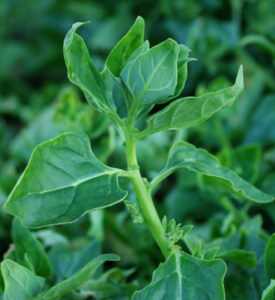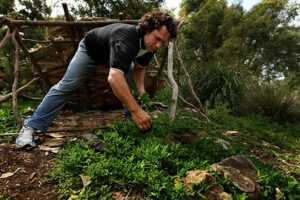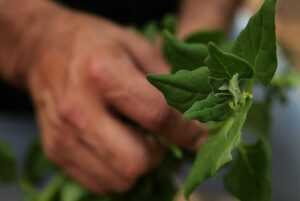A Green Summer
Not every green is able to flourish in the Israeli summer. Compared to the bountiful winter greens, in summer we make do mainly with summer lettuce (not as great as its winter counterpart), parsley (every once in awhile joined by coriander and dill, which briefly appear only to disappear within seconds), garlic chive, Swiss chard and New Zealand spinach.
The latter is a summery green guest that has been frequenting Chubeza for some years now. The New Zealand spinach is also known as Sea Spinach, (Captain) Cook’s Cabbage, Warrigal Greens, Botany Bay Spinach or in the native Māori language, Kokihi. In South Africa it is known as Duneweed.
All of these names describe a bit about its nature: this is a leafy crawling plant that grows mainly on the coast. It is a native of Australia and New Zealand where it was used extensively by the natives, and Captain Cook brought it to the European world. But let’s start from the beginning:
The plant’s scientific name is Tetragonia tetragonioides, and it belongs to the Aizoaceae family, characterized by fleshy plants that thrive along the seashores, in sands and dunes, and in the desert as well. It has been native to Australia and New Zealand for centuries, where the aborigines and native Maoris would gather it for food. When the Europeans reached the continent, they were taught which plants were edible, enabling them to survive. They coined the local plants and animals used for sustenance (including the wonder-plant tetragonia) “bush tuckers.”
Upon his fleet’s arrival to the Eastern coast of Australia in 1770, Captain Cook was justifiably concerned lest his sailors contract scurvy, a disease caused by lack of vitamin C. At sea, the crew was nourished solely from preserved food, so whenever they reached shore, the captain would set out in search of good fresh leafy greens to boost their diets. In Australia, his botanist chef found the tetragonia, and after enjoying its taste and nutritious value, they brought it home to England.
The Brits, already very fond of greens, were delighted to receive this exotic plant, and by the beginning of the nineteenth century it was to be found growing in the best of English vegetable gardens. Afterwards, there came a period when the tetragonia was passed over for hybrids and other “advanced” plants, but over the past decades, in keeping with the worldwide trend for local, homegrown products, the venerable plant is experiencing a comeback. White-aproned Australian chefs now gather it in the fields or purchase it from gourmet farmers. In leafy-green-loving Asia, too, it was happily received, growing across Eastern Asia and used as a substitute for Asian greens in stir-fried vegetable dishes.
This is how it grows, spread out and sprawling:
Though genetically unrelated to spinach, tetragonia received its name because it is used as a spinach substitute—but with one major edge over its namesake: Unlike spinach, which requires a cold climate and will not germinate in extreme heat or will bloom prematurely, New Zealand spinach is heat-resistant. On the other hand, it is very sensitive to cold, and frost will completely destroy it. This special relationship resulted in the New Zealand spinach becoming a good substitute for spinach during summer, while true spinach assumes the stage in winter. In the Middle East, tetragonia manages in our temperate winters, but our summers can sometimes be too dry for comfort.
In Israel, the substitution game became even more complex, with a small link to our chubeza as well. During the siege of Jerusalem, the city’s residents were encouraged to plant rooftop vegetable gardens, using their sewage water for irrigation. This is when the idea arose to gather wild mallow (chubeza). Schoolchildren were organized to go out and gather mallow leaves, which were then passed on to Tnuva, which packaged and marketed them as “New Zealand Spinach.” Around the world in just a few words: a Jerusalem mallow, marketed as New Zealand spinach, serves as a substitute for true spinach (which has its origins in Iran).
If you wish to grow this wonder plant yourself, following suit of so many gardeners worldwide who have transplanted it into their earth, there are several things you should know: First, it grows easily and enthusiastically and demands no special pampering. So much so thatarious parts of New Zealand and the United States it has become a weed that farmers try to get rid of, but usually it is very friendly. Like many other local “homegrown” plants, it is strong and does not attract too many pests or diseases, another reason for it to replace the sensitive spinach. Its seeds sprout slowly, due to an impenetrable seed shell (remember, it is accustomed to growing in moist areas in the southern hemisphere where the seeds’ problem was how not to go bad before sprouting…). The best way to help it sprout is to soak the seeds in cold water for 24 hours prior to seeding, or in hot water for three hours.
The mildly salty taste of New Zealand spinach is similar to that of true spinach, making it a proper substitute. But they do not look alike. Indeed, New Zealand spinach is green and edible, but this is as far as the resemblance stretches. The New Zealand mate’s diamond-shaped leaves are much smaller, fleshier and usually sharpened at the edges. It can substitute for spinach in any recipe, and in some dishes can replace Swiss chard, with whom it shares a fleshy texture. This fleshiness of the New Zealand spinach leaves allows it to retain more volume in cooking, thus when substituting for spinach or Swiss chard, use only half the amount of leaves called for in the recipe. (Note that the recipes below are original Australian recipes. The quantities are correct, as they are meant for New Zealand spinach!)
When you cook New Zealand spinach, separate the leaves from the coarser-textured stems. It is not recommended to consume these greens raw: the leaves contain cartonoid antioxidants which are important nutrients, but in their raw form they are oxalates which complicate digestion, particularly for those with gallstones or kidney problems. To remove most of the oxalates for easier digestion, blanch the New Zealand spinach for a few minutes, and then wash the leaves.
So yes, this is a substitute for true spinach, and well worth eating for its succulent taste and nutritious value—and for the fact that New Zealand spinach is one of the only leafy greens that manages to make its way into our summer boxes!
Bon Appétit! A summery and peaceful week to us all, Alon, Maya, Dror, Bat Ami and the Chubeza team
___________________
WHAT’S IN THIS WEEK’S BOXES?
Monday: New Zealand spinach, red potatoes, lettuce, tomatoes, watermelon, acorn squash, sage/thyme, cucumbers, scallions/chives, zucchini. Small boxes only: eggplant/fakus
Large box, in addition: Parsley root, parsley/coriander, cherry tomatoes/light bell peppers, corn!!!!
Wednesday: Parsley root/parsley/dill, red potatoes, lettuce, tomatoes, watermelon, acorn squash, sage/thyme, cucumbers, zucchini, eggplant/spaghetti squash, corn/fakus.
Large box, in addition: New Zealand spinach/Swiss chard, scallions/chives, cherry tomatoes/light bell peppers
________________
New Zealand Spinach Recipes:
New Zealand Spinach and Parsley Pesto
New Zealand Spinach Recipe From the Cauldrons of Captain Cook’s Chef



